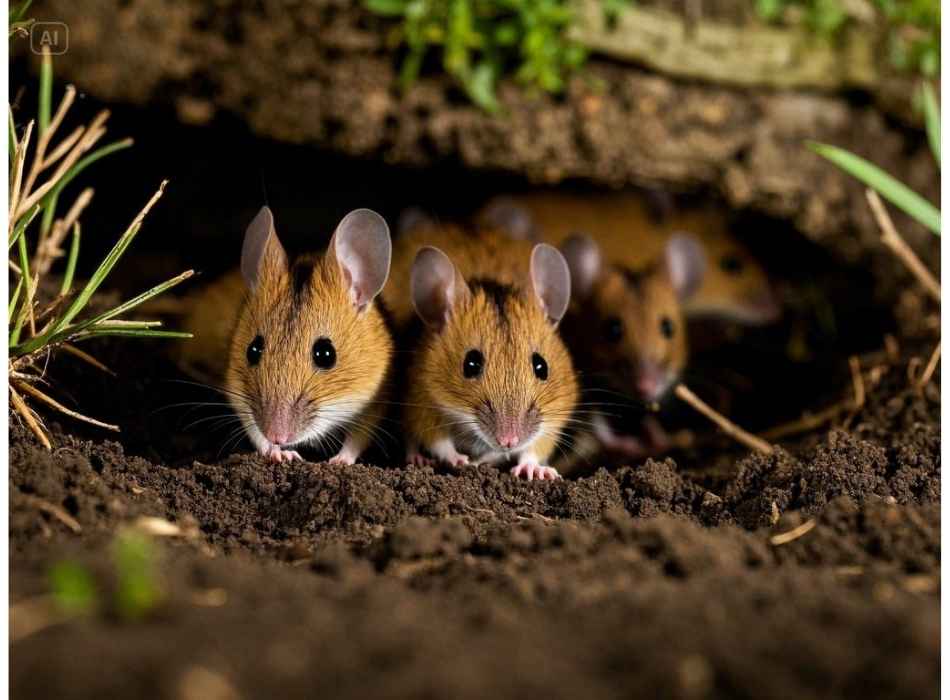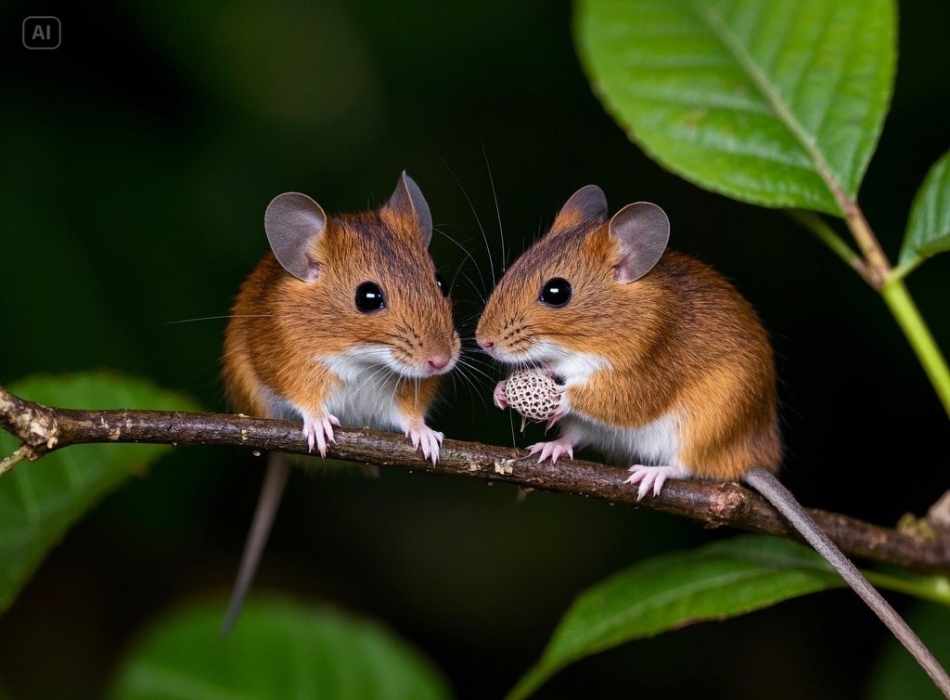You might imagine mice scurrying across a kitchen floor in dim lighting when you think about mice. But are mice truly nocturnal, or is that just a common misconception? Understanding the activity patterns of mice is crucial, whether you’re a homeowner trying to deal with an infestation, a pet owner caring for a mouse, or a pest control professional aiming to manage them effectively.
This guide will explore mice’s behavior, feeding and nesting patterns, and why knowing their active hours can help you better deal with these fascinating (and sometimes pesky) creatures.
What Does “Nocturnal” Mean?
Before we get into the specifics about mice, let’s define what it means to be nocturnal. Nocturnal animals are creatures that are most active during the night and typically rest during the day. This behavior usually helps them avoid predators and best use cooler nighttime temperatures.
Mice are generally classified as nocturnal, but their activity patterns are more nuanced than many realize. Read on to discover what drives their nighttime behaviors and how it impacts their interactions with humans and the environment.
Are Mice Truly Nocturnal?
Yes, mice are primarily nocturnal, but with some caveats. Most of their activity occurs at night, especially shortly after dusk and just before dawn. However, mice are opportunistic and adaptable creatures. Here are some key insights into their patterns:

- Peak Hours of Activity: Mice tend to come out in the early night hours when their predators are less likely to be active. Their keen sense of smell and hearing gives them the confidence to forage and explore even in low visibility.
- Crepuscular Tendencies: While technically nocturnal, mice also exhibit crepuscular behaviors, meaning they’re active during twilight. Dawn and dusk provide just enough ambient light for mice to scavenge while mainly staying hidden from predators like birds of prey.
- Adaptability: If mice occupy human spaces, like a noisy home or a busy office, they’ll occasionally shift their patterns. You’ll sometimes see mice during the day if their nest is in a highly disturbed area or if they’re driven by hunger. They can also adjust their activity levels based on Food, water, and shelter availability.
- Social Behavior: Mice are social creatures and usually live in small groups or colonies. They communicate through ultrasonic vocalizations, scent marking, and body language. These behaviors help them to establish dominance hierarchies and maintain group cohesion. In laboratory settings, mice are often used as model organisms for studying social behavior due to their complex interactions.
- Reproduction: Mice have high reproductive potential and can produce multiple litters yearly. Females reach sexual maturity at just 6 weeks old and can give birth to up to 10 offspring per litter. This rapid reproductive rate is one of the reasons why mice are commonly used in scientific research.
- Feeding: Mice are omnivorous, meaning they eat a variety of plant and animal-based foods. They have a keen sense of smell and can locate food sources using their whiskers. In the wild, mice feed on seeds, grains, fruits, and insects. Their diet is carefully controlled in laboratory settings to meet their nutritional needs.
- Habitat: Mice are found worldwide and can adapt to various environments, such as forests, grasslands, and even human-made structures like buildings and homes. They are excellent climbers and can create intricate burrow systems in soil or make nests in tree hollows.
- Behavior: Mice are primarily nocturnal, meaning they are most active at night. They have poor eyesight but excellent senses of hearing and touch, making them skilled at navigating in the dark. Mice communicate through various vocalizations, such as squeaks, chirps, and scent markings.
Why Are Mice Nocturnal?
Mice have evolved nocturnal behaviors for several reasons that enhance their survival. These include avoiding predators, optimizing their sensory abilities, and adapting to their environments:

- Safety from Predators: Predators such as owls, hawks, and snakes rely on sight to hunt. By being active at night, mice reduce their chances of being spotted and caught.
- Enhanced Senses: Mice have poor eyesight, but their other senses are sharp and well-suited for nighttime life. They use their whiskers and acute sense of smell to explore and find Food in total darkness.
- Habitat Adaptation: For mice living near humans, nighttime activity coincides with human sleeping hours, making it easier for them to sneak around undisturbed. In rural areas, mice are adapted to forage at night to avoid daytime predators such as birds of prey and snakes.
- Nocturnal Predators: Mice must also watch out for their predators who are active at night. These include owls, foxes, and coyotes. By being alert and active, mice can better evade these nocturnal hunters.
Typical Behavior of Mice at Night
If you’ve encountered mice in your home or workspace, here are some everyday nighttime habits to be aware of:
Foraging for Food
Mice spend a significant portion of the night searching for Food. They are opportunistic eaters who nibble on almost anything, including grains, fruits, seeds, and scraps from your pantry. Mice don’t need large amounts of Food to survive; about 3 to 4 grams a day is enough.
Nest Maintenance
Mice are constantly working to maintain their nests. You’ll often hear rustling or scratching sounds at night as they gather soft materials like fabric, paper, or insulation for their nesting sites.

Communication
Mice communicate using high-frequency sounds that are inaudible to humans. At night, you might hear chirping or squeaking if there’s a colony nearby. This is often a sign of mating or alerting other mice about potential dangers.
Exploring and Problem-Solving
Mice are curious creatures that use the cover of darkness to explore their surroundings. Their small size and flexible bodies allow them to squeeze through tight spaces, making it easy to access even the smallest cracks and crevices in your home. They are also excellent climbers, which enables them to reach high shelves and cabinets.
While their exploration may seem harmless, it can lead to potential problems for homeowners. Mice often chew on wires and insulation, causing damage to your home’s electrical system and leading to possible fire hazards. They can also contaminate Food and spread diseases through their urine and droppings.
If you suspect a mouse infestation in your home, promptly addressing the problem is essential. Ignoring the issue will only lead to further damage and health risks. The first step is identifying the source of the infestation. Look for signs of mice, such as droppings, gnaw marks on furniture or walls, and chewed food packaging. You may also hear scratching or rustling noises at night, indicating the presence of mice.
Once you have confirmed a mouse infestation, it’s time to take action. The most effective way to get rid of mice is to use traps or bait. Snap traps are commonly used and can be set with bait such as peanut butter or small pieces of cheese. Glue traps are another option, but they can be cruel, as they leave the mouse stuck and struggling until it eventually dies.
Why Should You Learn About Mice Activity Patterns?
Understanding that mice are nocturnal is key to managing their presence effectively, whether caring for a pet mouse or dealing with an unwanted infestation.
For Homeowners
If you’re trying to control a mouse problem in your home, recognizing their active hours will help you strategically place traps or bait. Setting them up at dusk or dawn increases your chances of catching these nighttime wanderers.
Look for signs of activity like:
- Droppings near food sources
- Chewed wires or packaging
- Nocturnal squeaking or scratching noises
Addressing an infestation promptly is essential because mice reproduce rapidly. Once established, a small population can grow exponentially within weeks.
For Pet Owners
Pet mice are delightful companions, but their nocturnal nature might take some time to adjust. If you’re caring for a mouse, provide an enriched environment with tunnels, chewable toys, and a running wheel to keep them entertained overnight. Consider placing their enclosure where their activity won’t disturb your sleep.
For Pest Control Professionals
Knowing a mouse’s activity patterns helps design effective intervention strategies for pest control workers. For example, using infrared cameras to monitor nocturnal movement or installing ultrasonic pest repellers can specifically target their nighttime behaviors.
Tips for Managing Mice, Nocturnal or Not
Whether you’re welcoming a pet mouse to your home or managing wild mice, here are some tips tailored to their nocturnal habits:
- Seal Entry Points: Mice can squeeze through holes as small as a dime. Inspect your property and seal any gaps to prevent entry.
- Store Food Securely: Use airtight containers for pantry items to eliminate accessible food sources.
- Clean Regularly: Crumbs, spills, and clutter attract mice. Regular cleaning and decluttering can deter them.
- Use Traps Strategically: If you’re using traps, place them along walls or near suspected entry points. Set them up in the evening for best results.
- Provide Enrichment for Pet Mice: Keep your pet mice physically and mentally stimulated with toys, hiding spots, and varied foods. This can prevent them from becoming bored and potentially causing damage to your home.
- Seal Entry Points: Inspect your home for potential entry points, such as gaps in walls or doors, and seal them with caulk or steel wool to prevent mice from getting inside.
- Consider Natural Repellents: Peppermint oil, mothballs, and other natural repellents may be effective at deterring mice. However, be cautious when using these products around pets or small children.
- Call a Professional: If you cannot control a mouse infestation on your own effectively, it’s best to call a professional pest control service. They will have the necessary expertise and equipment to effectively eliminate the mice from your home.
- Preventing Future Infestations: Once you’ve successfully eliminated mice from your home, it’s essential to prevent future infestations. This includes keeping your home clean and clutter-free, sealing up potential entry points, and setting traps periodically to catch new rodents.
- Educate Yourself: It’s important to educate yourself about mice and their behavior to understand better how to control them. Learn about their habits, nesting preferences, and preferred food sources to effectively target them in your pest control efforts.
- Stay Vigilant: Even after taking all necessary measures to eliminate and prevent mice infestations, it’s important to stay vigilant. Watch for any signs of mice activity, such as droppings or chewed wires, and address them immediately to avoid a full-blown infestation.
- Consider Professional Help: If you’re dealing with a persistent or severe mouse infestation, don’t hesitate to seek professional help. Pest control professionals have the experience and tools necessary to effectively eliminate mice from your home.
- Prevent Re-Infestation: Once you’ve successfully eliminated a mouse infestation, take steps to prevent re-infestation in the future. This may include regularly cleaning and decluttering your home, sealing up any potential entry points, and setting up traps or deterrents as a precautionary measure.
- Educate Yourself: Educating yourself on mouse behavior and habits is essential to prevent and deal with infestations effectively. Understanding how mice enter homes, what attracts them, and how they behave can help you take proactive measures to keep them out.
- Stay Vigilant: Even if you’ve successfully eliminated a mouse infestation, it’s important to stay vigilant and regularly check for any signs of re-infestation. Taking preventive measures such as setting up traps or monitoring potential entry points can help catch any new mice before they become a larger problem.
Lights Out, Mice Out
Yes, mice are primarily nocturnal creatures, but that doesn’t mean they won’t adapt to their environment when needed. Understanding their active hours can vastly improve control efforts for homeowners dealing with an infestation, and knowledge of their nocturnal tendencies helps create a more suitable environment for pet owners.
Mice are fascinating creatures, whether you’re marveling at their adaptability or managing their unwelcome appearances. By understanding their behaviors, you can address their needs—or eliminate their nuisances—more efficiently.











